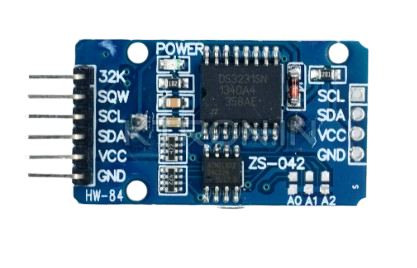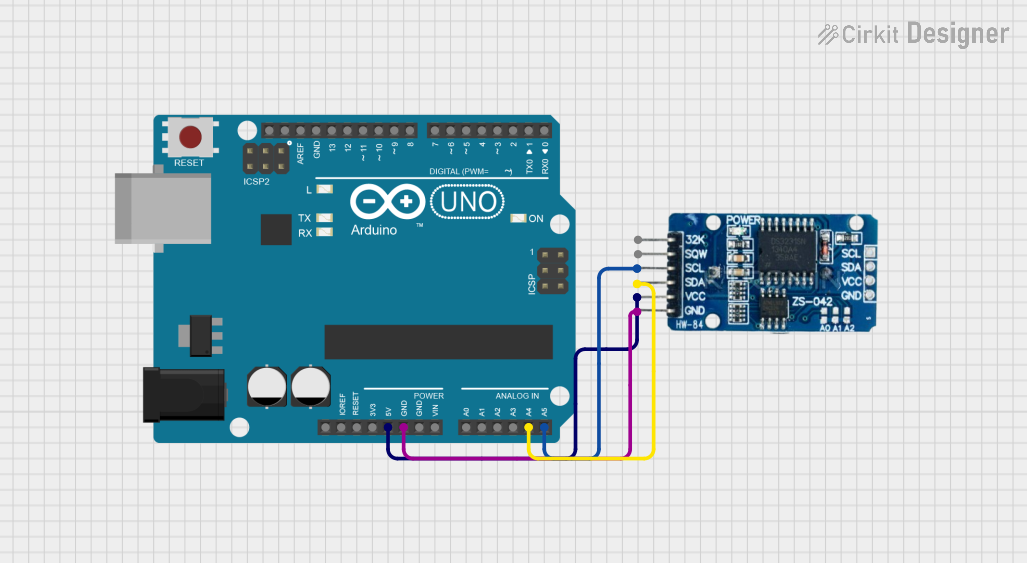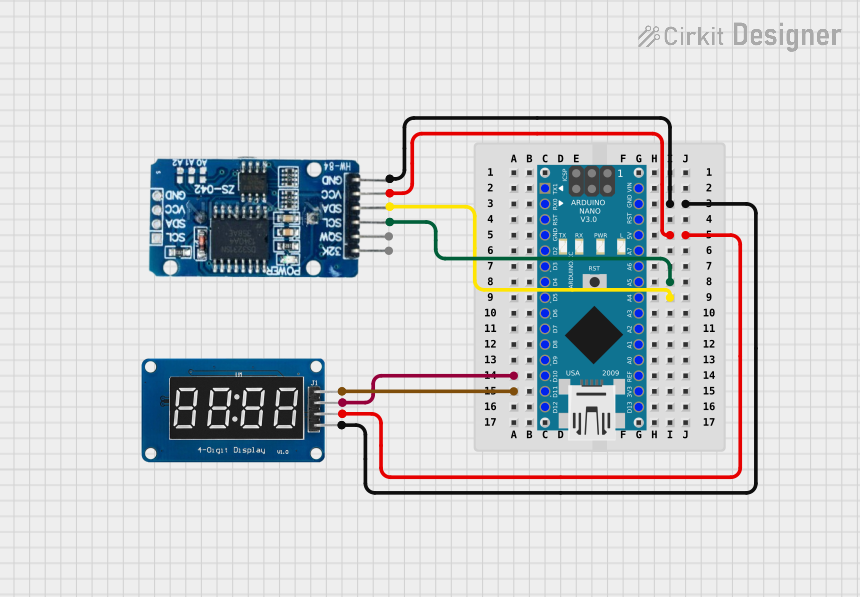
How to Use RTC DS3231: Examples, Pinouts, and Specs

 Design with RTC DS3231 in Cirkit Designer
Design with RTC DS3231 in Cirkit DesignerIntroduction
The Real-Time Clock (RTC) DS3231 is a low-cost, extremely accurate I2C real-time clock with an integrated temperature-compensated crystal oscillator (TCXO) and crystal. The device incorporates a battery input, and maintains accurate timekeeping when main power to the device is interrupted. The integration of the crystal resonator enhances the long-term accuracy of the device and reduces the piece-part count in a manufacturing line. Common applications of the DS3231 include timekeeping for embedded systems, network servers, data loggers, and other devices that require precise time stamping.
Explore Projects Built with RTC DS3231

 Open Project in Cirkit Designer
Open Project in Cirkit Designer
 Open Project in Cirkit Designer
Open Project in Cirkit Designer
 Open Project in Cirkit Designer
Open Project in Cirkit Designer
 Open Project in Cirkit Designer
Open Project in Cirkit DesignerExplore Projects Built with RTC DS3231

 Open Project in Cirkit Designer
Open Project in Cirkit Designer
 Open Project in Cirkit Designer
Open Project in Cirkit Designer
 Open Project in Cirkit Designer
Open Project in Cirkit Designer
 Open Project in Cirkit Designer
Open Project in Cirkit DesignerTechnical Specifications
Key Technical Details
- Time Accuracy: ±2ppm from 0°C to +40°C
- Battery Backup Input: 2.3V to 5.5V
- Operating Voltage: 2.3V to 5.5V
- Operating Temperature: -40°C to +85°C
- Digital Temp Sensor Output: ±3°C accuracy
- Memory: 236 bytes of non-volatile RAM
Pin Configuration and Descriptions
| Pin Number | Name | Description |
|---|---|---|
| 1 | 32K | 32kHz Output |
| 2 | SQW | Square Wave/Interrupt Output |
| 3 | SCL | Serial Clock Input |
| 4 | SDA | Serial Data Input/Output |
| 5 | VCC | Supply Voltage |
| 6 | GND | Ground |
| 7 | BAT | Battery Input for Any Standard 3V Lithium Cell or Other Energy Source |
| 8 | NC | No Connection (Do not connect) |
Usage Instructions
Interfacing with an Arduino
To use the DS3231 with an Arduino, connect the following pins:
- DS3231 SCL to Arduino A5 (or the SCL pin for your specific Arduino)
- DS3231 SDA to Arduino A4 (or the SDA pin for your specific Arduino)
- DS3231 VCC to Arduino 5V
- DS3231 GND to Arduino GND
- Optionally, DS3231 32K to an input pin if you need a 32kHz signal
- Optionally, DS3231 SQW to an interrupt pin if you need a square wave or alarm interrupt
Important Considerations and Best Practices
- Always connect the battery to the DS3231 to ensure timekeeping during power outages.
- Avoid placing heat-generating components near the DS3231 to prevent temperature-induced inaccuracies.
- Use pull-up resistors on the SDA and SCL lines if your Arduino board does not have them built-in.
Example Arduino Code
#include <Wire.h>
#include <RTClib.h>
RTC_DS3231 rtc;
void setup() {
Serial.begin(9600);
if (!rtc.begin()) {
Serial.println("Couldn't find RTC");
while (1);
}
if (rtc.lostPower()) {
Serial.println("RTC lost power, let's set the time!");
// The following line sets the RTC to the date & time this sketch was compiled
rtc.adjust(DateTime(F(__DATE__), F(__TIME__)));
}
}
void loop() {
DateTime now = rtc.now();
Serial.print(now.year(), DEC);
Serial.print('/');
Serial.print(now.month(), DEC);
Serial.print('/');
Serial.print(now.day(), DEC);
Serial.print(" ");
Serial.print(now.hour(), DEC);
Serial.print(':');
Serial.print(now.minute(), DEC);
Serial.print(':');
Serial.print(now.second(), DEC);
Serial.println();
delay(1000);
}
Troubleshooting and FAQs
Common Issues
- Time Not Accurate: Ensure the battery is properly installed and charged.
- No Communication: Check the SDA and SCL connections and ensure pull-up resistors are in place.
- Device Not Found: Make sure the DS3231 is powered and the correct I2C address is being used in your code.
Solutions and Tips for Troubleshooting
- If the time drifts significantly, replace the battery and reset the time.
- Use the I2C scanner sketch to check if the Arduino is detecting the DS3231.
- Ensure the Arduino library for the DS3231 is correctly installed and included in your sketch.
FAQs
Q: Can the DS3231 be used in battery-powered applications? A: Yes, the DS3231 is suitable for battery-powered applications due to its low power consumption.
Q: What is the purpose of the 32K pin? A: The 32K pin outputs a 32.768kHz signal that can be used to drive a microcontroller timer or as a clock reference.
Q: How do I set alarms on the DS3231? A: Alarms can be set using the RTC library functions. Refer to the library documentation for specific instructions.
Q: What is the battery life expectancy when using the DS3231? A: Battery life depends on the type of battery used and the environmental conditions but typically lasts for 2+ years with a standard 3V lithium cell.